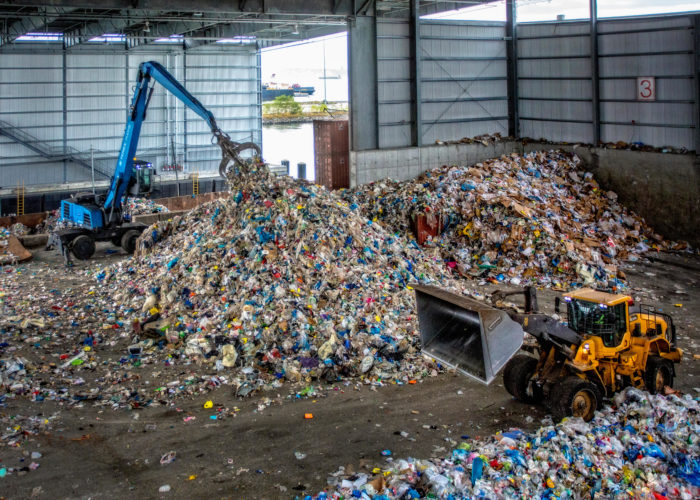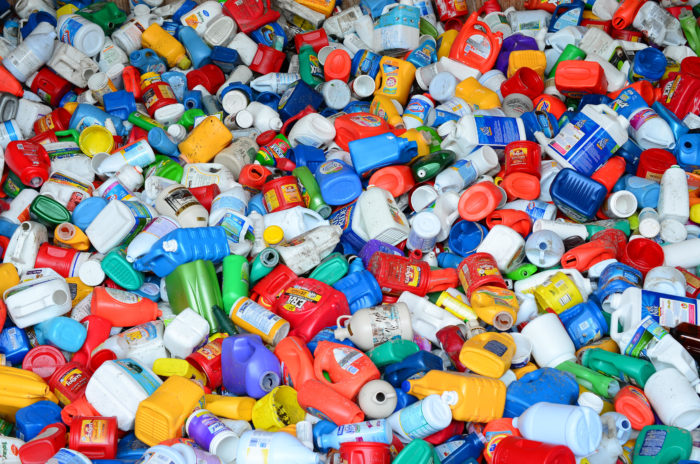I’m religious about reusable shopping bags, as is mandatory for a resident of Park Slope. And yet, thanks to occasional lapses, the cabinet under my sink holds 37 flimsy plastic bags from Steve’s 9th Street Market and Fairway.
These bags will get reused until they split, but eventually they’ll end up floating in the ocean, a neighbor’s tree (sorry, guys), or sitting around in a landfill for a few hundred years. Most single-use plastic bags, even if you put them out for recycling, don’t get recycled. On a recent visit to the Brooklyn Zoo, an employee showed my kids how a plastic bag floating in water resembled a jellyfish, and explained why that’s killing sea turtles, who love to nosh on jellyfish. I’ve been sufficiently shamed.
Multiply my embarrassing cabinet contents by every resident of New York City and it adds up to a hefty pollution problem: single-use plastic bags alone make up 1,700 tons of residential garbage each week, according to a January report from the New York State Plastic Bag Task Force. Statewide, we’re using 23 billion plastic bags a year. And at least 8 million metric tons of plastic flow into the ocean annually. It ends up inside of fish, and if you eat fish, it ends up inside of you.
Proposals to reduce the use of plastic bags and bottles have been popping up in New York recently, local manifestations of the ever-growing awareness of plastic pollution. Cities across the U.S. have been enacting bans and/or fees on plastic bags to encourage shoppers to bring their own. The Wildlife Conservation Society is taking on the scourge of plastic straws (though some people with disabilities object until concerns are resolved). And the United Kingdom is considering a ban on plastic straws, stirrers, and cotton swabs.

Mountains of discarded containers are sorted at one of New York City’s recycling centers. One center in Brooklyn welcomes visitors (Photo by Thom Lang/Alamy)
Even private companies are getting in on the movement: Marriott and InterContinental Hotel Group chains are moving from tiny shampoo and conditioner bottles to pump bottles mounted in showers. In the U.K., 40 companies including Coca-Cola and Nestle have signed onto an agreement to slash the amount of plastic packaging they use, with dramatic cuts by 2025.
Ban the Bag?
The day after Earth Day last month, Gov. Andrew Cuomo proposed a bill to ban all single-use plastic bags in the state. While an outright ban sounds consequential, critics say it would not be effective in getting rid of bags, and could actually make the problem worse.
City Council Member Brad Lander of Brooklyn (39th District), called Cuomo out for “election-year, Earth Day politics,” issuing a withering response to the proposal. Cuomo’s bill, he noted, had “no legislative co-sponsors, and was introduced after the governor’s budget leverage is gone. … So there’s no reason to believe it will go anywhere.”
In 2016, the City Council, in a bill backed by Lander, approved a five-cent fee on plastic bags, noting that they’d been necessary in other cities to reduce plastic-bag use. In 2017, Cuomo squashed the bill, saying it was “deeply flawed.”
Plastic-bag policy expert Jennie Romer says fees of a few cents a bag, not outright bans, are the most proven way to get people to carry their own reusable bags.
Cities enacting plastic-bag bans, like Chicago and San Francisco, found that shoppers would take whatever bags were still available for free, including thicker plastic bags, or paper bags, which have their own environmental consequences. Fees were required to make the reusable-bag habit stick. “When customers are suddenly presented with the question ‘Would you like to purchase a bag for that?’ bag consumption drops dramatically,” Romer wrote in an editorial for HuffPost.
Ban the Bottle?
The war on plastic has inspired local legislation as well. In April, two new bills were introduced in the City Council. One, from Council Member Ben Kallos of Manhattan, would block the sale of single-use water bottles in city parks and beaches. Another, from Council Member Rafael Espinal Jr. of Brooklyn (37th District), would go further, banning the sale of all single-use plastic bottles in parks and beaches–goodbye, Cokes and Gatorades. “If we just push with a ban on water, we’re dealing with half the problem,” says Espinal.
Statements from the council members said the legislation was a response to President Trump’s repeal of a ban on selling bottled water at national parks. More than 1 billion beverage bottles—or 315 bottles per person—were sold in the U.S. in 2014, according to the Container Recycling Institute.
Espinal says he has become increasingly concerned by reports of plastic in the ocean. “If we don’t come up with a plan, data shows that by 2050 we will have more plastic in our oceans than we do fish,” Espinal says. “One of my goals is to target consumer behavior around plastic consumption.”

The plastic problem includes more than just bags and water bottles, as this recycling bin illustrates (Photo by David Nelson/Alamy)
Were it up to him, he’d target all plastics on the market, but he sees starting in city parks and beaches as a “common-sense approach to changing New Yorkers’ behavior and pushing them to [use] more reusable products.” Public testimony on the two council bills will be heard by the Committee on Parks and Recreation, which will make a recommendation to the full council.
What about the health issue–keeping people hydrated? Espinal supports building out water infrastructure in city parks, using existing fire hydrants, water fountains, and sprinkler lines to create more water-bottle filling stations. After all, he says, “New York City has the best tap water in the country.” He added: “Vendors who might feel the brunt of the impact might switch to selling boxed water, or finding more creative ways to refill the bottles New Yorkers will be carrying.”
Creativity may also be the key to ending our decades-long affair with plastic bags, says Prof. Karol Murlak, who teaches a class called “The Future of Take-Out,” at Pratt Institute in Brooklyn, in collaboration with the New York State Department of Environment Conservation. Murlak says plastics are recyclable and can be sustainable when used in a smart way. “The real problem lies in single-use plastic and overpackaging. When people realize how harmful plastic is, they will think twice before they take another plastic bag or fork,” he says.
Students in his class were tasked with coming up with alternatives for the typical takeout amenities New Yorkers know so well: the plastic containers, the plastic forks, the plastic lids. In many cases, he says, plastic can be replaced with paper or wood. Pratt students also looked to nature itself for answers, testing different bio materials for food packaging.
“Nature provides an amazing choice of renewable and biodegradable material including mycelium, the vegetative part of a fungus; agar, a type of algae; or chitin, the major constituent in the exoskeletons of arthropods,” Marlak says. “Packaging farms are not as futuristic as they sound.”
(With reporting by Arden Phillips)